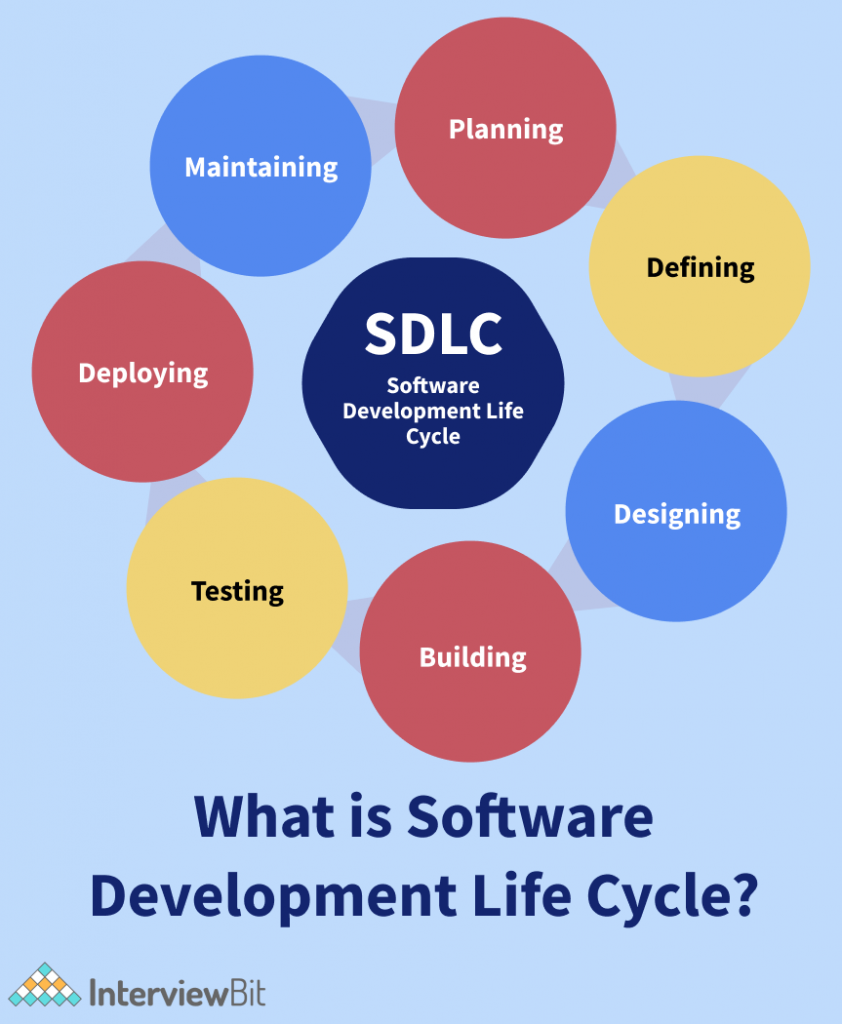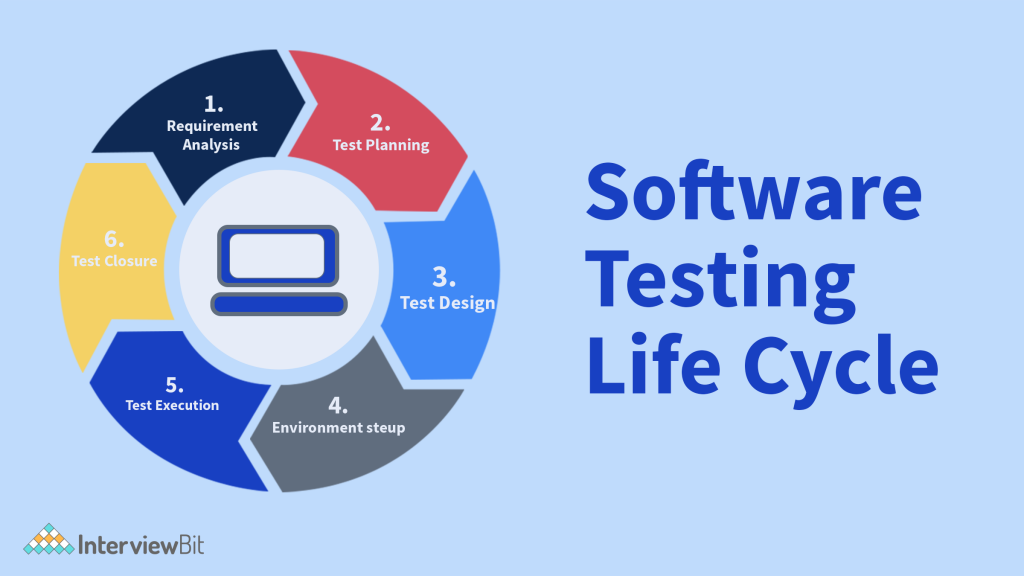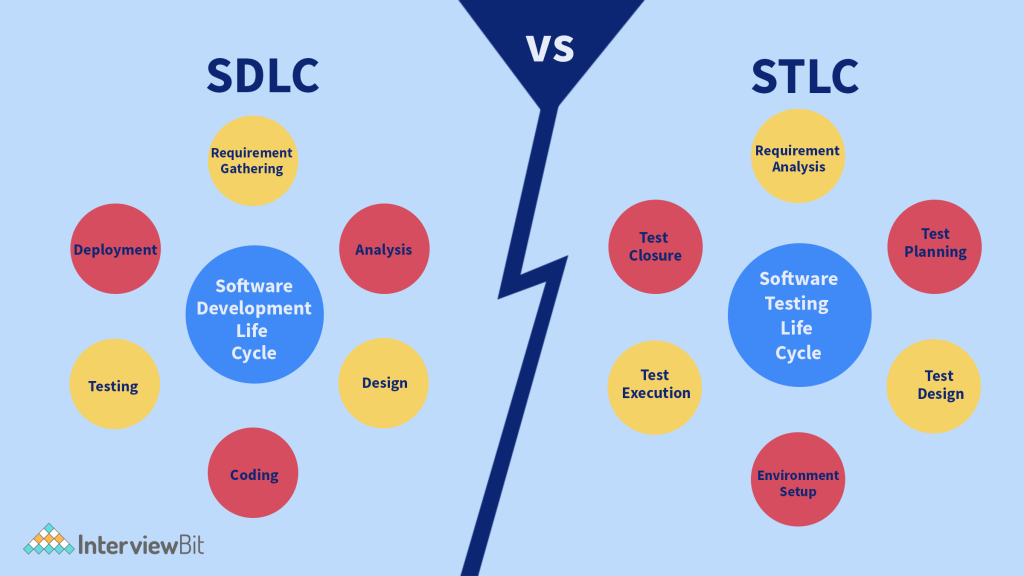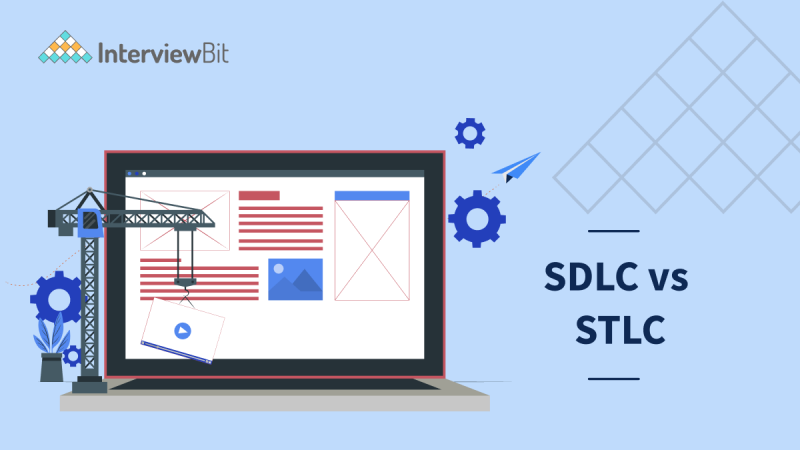Software development is the process of planning, designing, creating, testing, and deploying a software product to perform a specific function. It may seem simple to develop a small program, but building enterprise-level software is quite challenging. Consequently, it is important to follow a proper methodology when developing the software product. In this case, SDLC (Software Development Life Cycle) and STLC (Software Testing Life Cycle) are important. STLC and SDLC are both interrelated in some way, or you could say that one is the predecessor to the other. SDLC refers to a sequence of activities during the software development process, whereas STLC refers to a sequence of activities during software testing. The SDLC is primarily concerned with software development. It is for a simple reason: if you are developing something for a specific purpose (client need), then before deploying it, it must be tested. SDLC and STLC differ in their life cycles, but before looking at their differences, let’s see what SDLC and STLC are exactly.

What is SDLC?
The Software Development Life Cycle (SDLC) describes the process of various activities followed by the software industry to produce working software. It entails planning, requirement gathering, analysis, designing, implementing, testing, and maintenance. In other words, it covers the entire life cycle of software, such as its conception to its during the SDLC, the actual code is developed, and work is carried out according to the design documents. The SDLC life cycle consists of phases, each of which has its own processes and deliverables. Our software applications can be developed in a well-defined and systematic manner with the help of SDLC. The end result of the process should be a software system that meets or exceeds customer expectations. that is completed within estimated timeframes and within budget and is cost-effective to maintain and enhance.

Key Features of SDLC
- Detailed documentation of the model structure & functions, as well as the results of testing, are available.
- Step-by-step, the project can be completed before embarking on another. Each unit of the project is identifiable and distinct.
- An efficient risk management approach is used to reduce the exposure to risk.
- A clear understanding of the roles and responsibilities of developers, designers, business analysts, and project managers.
- Timely, cost-effective, and deliverable results.
Why SDLC?
The following are some reasons why SDLC is important in software development:
Confused about your next job?
- The goal is to deliver high-quality software that meets our customers’ expectations.
- Each stage/phase of the process is followed by a formal review that ensures optimum management control.
- Ensures that all stakeholders in the development process are aware of the project planning process.
- With SDLC, you can generate considerable documentation about your system.
- Several intermediate products are produced, all of which can be reviewed in order to determine if they meet the specifications and the needs of the users.
- In every phase, there are specific deliverables, entry criteria, and exit criteria.
- A sequential development process is ideal for small- to mid-sized projects with clear requirements.
- It allows you to lower project risk and management plan overhead.
- A faster and more efficient development process.
What is STLC?
The Software Testing Life Cycle (STLC) consists of a series of activities to ensure the quality of the software application as part of the testing process. The STLC is performed by the testing team to ensure the software is of high quality. It should ensure that each new release rolls out smoothly and successfully. It is an integral part of the SDLC but only applies to the testing phases. STLC phases may be repeated multiple times during product development before a product is considered fit for done. An analysis of all tests conducted during the software development life cycle is provided in a document called the test closure. Additionally, a detailed analysis of the fixed bugs and errors is included. STLC involves the testing team preparing the test environments and executing test cases as part of the testing process to ensure the software is of high quality.

Key Features of STLC
- Analyzing system requirements gathered from clients and stakeholders.
- Aids you in developing a traceability matrix (an important document in software development used to track current project requirements and make sure that they are being met.)
- Determines the testing method and type.
- Prioritizes the feature to be tested the most.
- Assess automation feasibility (a checklist that contains various factors that can be used to determine whether to automate a test case).
- Describe the environment in which the test needs to be run.
- Following the completion of the development phase, the Testers are able to execute the Test Cases. This helps in finding bugs in the initial phase.
Why STLC?
The following are some reasons why STLC is important in software development:
- Quality improvement activities are carried out in different ways.
- The execution phase produces a software release of higher quality.
- The STLC improves the consistency, efficacy, and sophistication of the testing process.
- Easily understood and implemented regardless of the level of the testing process.
- In the project formulation process, time constraints are strongly incorporated.
- Tests are conducted on each module before proceeding with the next.
- Specific requirements are compared to the results obtained.
- Removing its flaws while the product is in its earliest and most profit-making stages.
- Improving the quality of the development process.
- Optimizing quality control throughout the SDLC.
- Assuring that not only the Client but also the Users of the product receive a quality product.
Difference Between SDLC and STLC

| Parameters | SDLC | STLC |
| Definition | SDLC, or software development life cycle, relates mainly to software development and includes all phases of software development, including testing. | In essence, STLC is related to software testing, meaning that it is a software testing process that entails several phases. |
| Relationship | As a whole, it covers the entire life cycle of the software and can be considered the predecessor. | Since it is part of SDLC and only involves testing, it is considered a child or successor. |
| Focus/Goal | SDLC aims to manage the entire process of software development from start to finish and to deliver a quality product that meets customer needs. | The focus is solely on test development and helps to make the testing process more sophisticated, consistent, and useful. |
| Performed | Phases of the SDLC are completed before those of the STLC. | Phases of STLC are carried out after the phases of SDLC. |
| Requirement Gathering | Business Analysts and Product Analysts collect requirements and prepare a Development Plan during the Requirements collection phase of the SDLC. | The QA (Quality Assurance) team will analyze requirement documents such as functional and non-functional requirements, and then prepare a System Test Plan as part of the Requirement Analysis phase of the STLC. |
| Different phases | The SDLC includes the following phases:Requirements Collection/PlanningAnalysis/DefiningDesigning the software programming or Coding (Building the Software)TestingDeployment/InstallationMaintenance | The STLC includes the following phases:Requirement AnalysisTest PlanningTest DevelopmentTest Environment SetupTest ExecutionTest Closure |
| Objective | Throughout the SDLC process, the intent is to overcome any hurdle on the way to successful software development. | Testing is only intended to find any weaknesses or pitfalls in the system. |
| Design phase | SDLC involves planning and designing software based on the requirements of the development team. | STLC involves the planning of tests by the testing team (Test Architect or Test Lead). |
| Coding phase | In this phase, programmers start writing code according to the designed document in any programming language to build the system from scratch. | Test cases and test scripts are developed by the testing team (quality assurance team) to verify the product’s quality. They prepare the test environment and execute the tests. |
| Environment Setup | As soon as the development team has written the code, they set up a test environment to validate it. | The testers ensure the test environment is prepared based on the prerequisites and conduct smoke tests to determine if the environment is stable enough for testing the product. |
| Testing Phase | The objective of this phase is to test the software. Among the activities included in this testing are Unit, Integration, System, Retest & Regression testing, etc., and the development team also participates in fixing reported bugs. | System integration testing is then conducted based on the test cases. All bugs and errors are reported, retested, and fixed. The product is also subject to regression tests and is signed off as soon as it meets the exit criteria. |
| Deployment/Product Release | As soon as the application has been approved by the various testing teams, it is deployed in a production environment for real end-users. | After the product has been deployed, smoke testing and sanity testing take place in the production environment, and the testing team prepares test reports and an analysis matrix for analyzing the product. |
| Maintenance | If necessary, post-deployment support, enhancement, and update are included. | The QA team runs regression tests to check deployed maintenance code. The team maintains test cases and automated scripts to make sure that tests are updated. |
| Members Required | Throughout the SDLC, more people (developers) are needed. | The QA team runs regression tests to check deployed maintenance code. The team maintains test cases and automated scripts to make sure that tests are updated. |
| Output | The end result of SDLC is the creation of reusable software systems. | STLC results in a tested software system. |
Conclusion
As part of any new software development initiative, SDLC and STLC are just two of many tools that organizations should keep in their toolkit. SDLC provides a structured and phased approach to software development. The STLC can be utilized to validate such software development projects for performance, reliability, and functionality. STLC and SDLC both serve as a framework for software development and testing. Together, SDLC and STLC can assist all stakeholders, including customers, in understanding the entire software development and testing cycle.
SDLC vs. STLC is often a topic of discussion among those studying software development and wondering if they are complementary or opposite in nature, independent or separate. In this blog, we have discussed in detail SDLCs and STLCs and how they differ from each other. Hopefully, this blog will provide you with a better understanding of SDLC vs STLC.
FAQs
Q.1: Is STLC a part of SDLC?
Ans: Definitely, STLC (Software Testing Life Cycle) is a part of SDLC (Software Development Life Cycle). STLC is confined exclusively to the testing phase, which makes it important for complete software development. SDLC covers the entire development process of a software or product, while STLC just comprises the testing phase. In a sense, STLC can be called a subset of SDLC.
Q.2: What are the phases of STLC?
Ans: Following are the 6 phases of the STLC ( Software Testing Life Cycle):
- Phase 1: Requirement Analysis.
- Phase 2: Test Planning.
- Phase 3: Test Design.
- Phase 4: Test Environment Setup.
- Phase 5: Test Execution.
- Phase 6: Test Cycle Closure.
Q.3: Is Agile similar to SDLC and STLC?
Ans: Agile is not the same as SDLC and STLC. Traditional SDLC models, like the waterfall model, are based on a predictive approach, while Agile focuses on adaptive methods for software development. In an agile approach, there is no detailed planning involved and tasks are defined only in terms of features that need to be developed. In contrast, SDLC involves planning in detail and follows a systematic approach to developing software.







 Join WhatsApp Group
Join WhatsApp Group


